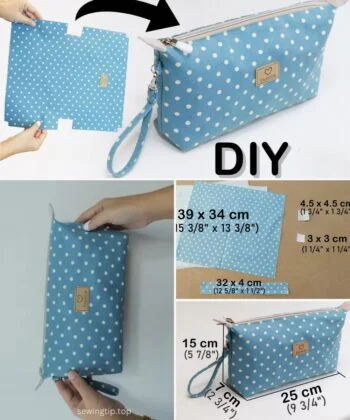Creating a zipper pouch is one of the most rewarding sewing projects for beginners and seasoned crafters alike. Not only does it provide a practical way to store everyday items, but it also opens up countless opportunities for creativity. Whether you want to play with fabric scraps, experiment with a quilt pattern, or simply learn the basics of sewing with zippers, this project is a great starting point.
This tutorial will walk you through each step of making a zipper pouch. From choosing the right fabrics and materials to assembling and customizing your design, you’ll gain both the skills and confidence to create your own unique pouch. By the end, you’ll not only have a finished product but also a deeper understanding of sewing techniques that can be applied to future projects, including quilting and other crafts.
The best part? Zipper pouches are endlessly customizable. You can experiment with quilt blocks, vibrant quilt patterns, or even repurpose old textiles to give your pouch a personal touch. So, gather your supplies, set up your sewing machine, and let’s get started on this fun and practical sewing adventure.
Materials You’ll Need
Before diving into the sewing process, it’s important to have everything ready. The materials for this project are simple, and many can be found in your sewing stash or at your local fabric store. By preparing in advance, you’ll ensure the process flows smoothly without unnecessary interruptions.
Here’s what you’ll need:
- Outer fabric (cotton, canvas, or even quilt blocks)
- Lining fabric
- One zipper (7–9 inches, depending on your desired pouch size)
- Matching thread
- Sewing machine with zipper foot
- Scissors or rotary cutter
- Pins or fabric clips
- Optional: batting or fusible interfacing for added structure
If you’re a quilting enthusiast, this is a fantastic opportunity to incorporate leftover quilt scraps into your pouch design. Using quilted fabric adds both durability and charm. A quilt pattern can also be featured on the exterior for a personalized, handmade look that makes your pouch stand out.
Cutting Your Fabrics
Start by deciding on the size of your pouch. A common size is around 8 inches wide by 6 inches tall, but you can adjust it depending on your needs. Once you’ve determined the size, cut two pieces of your outer fabric and two pieces of lining fabric to the same dimensions. If you’re using batting or interfacing, cut those pieces as well.
For those who enjoy quilting, this is the perfect stage to experiment with different quilt patterns. You could create a patchwork design for the outer panels or use a quilt block you’ve already made. This will give your pouch a unique look while practicing skills that are also useful in quilt making.
Make sure all your fabric pieces are neat and square. Using a rotary cutter and quilting ruler will help keep your edges straight and accurate. Precise cutting ensures easier sewing later on and results in a more polished pouch.
Preparing the Zipper
The zipper may seem intimidating at first, but once you try it, you’ll see how easy it is to work with. Begin by placing your zipper face down along the top edge of one piece of outer fabric. Position one lining piece on top, with right sides facing. The zipper should be sandwiched between the fabrics.
Pin or clip the layers together to prevent shifting, and then sew along the edge with a zipper foot. The zipper foot allows you to stitch closely to the zipper teeth, creating a clean and professional finish. Go slowly, especially if this is your first time sewing zippers.
Once finished, press the fabrics away from the zipper and topstitch along the edge. This step keeps the fabric flat and prevents it from getting caught in the zipper. Repeat the process for the other side of the zipper with the remaining outer and lining fabric.
Sewing the Pouch Body
With the zipper installed, open it halfway before sewing the pouch body. This is important because it allows you to turn the pouch right side out later. Align the outer fabrics together, right sides facing, and the lining fabrics together as well. Pin or clip around the edges to keep everything secure.
Sew around all four sides, leaving a small gap (about 2–3 inches) in the lining’s bottom edge. This gap will be used to turn the pouch right side out. Make sure to backstitch at the beginning and end of your seams for durability.
If you want your pouch to have a boxed bottom (for extra depth), mark and sew small triangles on each bottom corner before turning it right side out. This technique is also common in quilted bags and adds structure to the finished product.

Turning and Finishing
After sewing the pouch body, carefully pull it right side out through the gap in the lining. Push out the corners with a blunt tool, such as a chopstick or knitting needle, to give the pouch a neat shape. Once everything is turned, stitch the gap in the lining closed, either by hand with a slip stitch or with a quick machine stitch.
Tuck the lining inside the pouch and give it a final press with your iron. At this stage, you’ll see your zipper pouch fully come to life. The zipper should glide smoothly, and the pouch should hold its shape nicely.
If you added quilted fabric or batting, the pouch will feel more structured and cozy, almost like a miniature quilt project. This is one of the reasons many quilters enjoy making zipper pouches—they bring the beauty of quilting into everyday use.
Personalization Ideas
One of the joys of making a zipper pouch is the endless room for creativity. You can personalize your pouch in countless ways, ensuring each one is unique and tailored to your style or the recipient’s taste.
Try experimenting with quilt patterns on the outer panels. A simple patchwork design made from fabric scraps can create a colorful and eye-catching look. Alternatively, use a single bold quilt block to make a statement. This not only makes your pouch stand out but also allows you to practice your quilting skills.
Other ideas include adding appliqué, embroidery, or fabric paint. You can even sew on a fabric label with a favorite quote or your initials. The beauty of sewing is that it allows you to combine techniques—quilting, embroidery, and patchwork—into one small yet impactful project.
Why This Project is Perfect for Beginners
Learning how to make a zipper pouch is one of the best ways to gain confidence in sewing. It introduces important skills like installing zippers, working with linings, and sewing with precision. Yet, it remains simple enough to complete in an afternoon, even for beginners.
Because it requires only small amounts of fabric, this project is also cost-effective. You can use fabric scraps, old jeans, or even cut sections from an old quilt to breathe new life into materials you already own. This makes the pouch both eco-friendly and budget-friendly.
Additionally, zipper pouches make wonderful gifts. Whether for friends, family, or coworkers, they’re thoughtful, practical, and customizable. Once you’ve mastered the basic steps, you’ll find yourself making pouches for makeup, stationery, travel, or even as unique quilted storage bags.
Share Your Creations
Now that you’ve completed your zipper pouch, it’s time to celebrate your achievement! Sewing is a craft best enjoyed when shared with others, and your project can inspire fellow makers. Snap a photo of your finished pouch and share it with your sewing group, on social media, or with friends who love handmade crafts.
Sharing your project not only highlights your creativity but also encourages others to try new things. Whether you’ve used a quilt pattern, patchwork scraps, or a sleek modern fabric, your pouch reflects your unique style and effort.
So, grab your fabrics, play with colors and quilt designs, and make as many zipper pouches as your heart desires. Each one tells its own story, stitched together by your imagination and creativity. And don’t forget to pass along this tutorial so more people can discover the joy of sewing.
